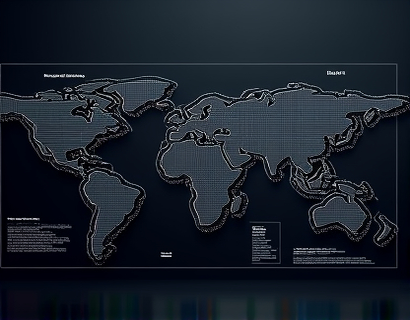Optimizing Graph Theory and Fluid Dynamics Research: Cutting-Edge Software for Insightful Analysis and Performance Enhancement
In the realm of mathematical modeling and fluid mechanics, the integration of advanced software solutions has revolutionized the way researchers and engineers approach complex problems. This article delves into the cutting-edge software tools that are transforming graph theory and fluid dynamics research, offering unprecedented insights and performance optimization. By leveraging these sophisticated tools, professionals can streamline data analysis, enhance visualization, and drive innovative discoveries in their respective fields.
Enhancing Graph Theory Research
Graph theory, a fundamental area of discrete mathematics, deals with the study of graphs, which are mathematical structures used to model pairwise relations between objects. In recent years, the complexity of graphs has increased exponentially, necessitating advanced software to handle and analyze these intricate networks. Modern software solutions provide robust algorithms and efficient data structures that enable researchers to explore large-scale graphs with greater ease and accuracy.
One of the key features of these tools is their ability to perform sophisticated graph algorithms, such as shortest path finding, minimum spanning trees, and network flow optimization. These algorithms are crucial for understanding the connectivity and efficiency of various systems, from social networks to transportation infrastructures. By automating these computations, researchers can focus on higher-level analysis and interpretation of results, rather than getting bogged down in manual calculations.
Advanced Visualization Techniques
Visualization plays a critical role in graph theory research, as it allows for the intuitive understanding of complex relationships and patterns within graphs. Advanced software solutions offer state-of-the-art visualization tools that can render graphs in 2D and 3D, providing multiple perspectives and interactive features. These visualizations help researchers identify clusters, communities, and other structural properties that might not be apparent from raw data.
For instance, force-directed layouts can simulate the physical forces between nodes, resulting in a visually appealing and informative representation of the graph. Additionally, color-coding and size variations can be used to highlight specific attributes or properties of nodes and edges, making it easier to spot trends and anomalies. Such visual aids are invaluable for presenting findings to both technical and non-technical audiences.
Revolutionizing Fluid Dynamics Research
Fluid dynamics, the study of fluids in motion, is a critical field with applications ranging from aerospace engineering to environmental science. The complexity of fluid flow simulations demands high-performance computing and sophisticated software to model and analyze these phenomena accurately. Advanced software solutions in fluid dynamics have significantly enhanced the capabilities of researchers and engineers, enabling them to tackle more intricate problems and obtain more precise results.
One of the most significant advancements in fluid dynamics software is the implementation of finite volume, finite element, and lattice Boltzmann methods. These numerical techniques allow for the discretization of fluid domains into manageable elements, facilitating the solution of partial differential equations that govern fluid behavior. High-fidelity simulations can capture a wide range of flow conditions, from laminar to turbulent, providing detailed insights into flow patterns, pressure distributions, and heat transfer.
Real-Time Simulation and Optimization
Real-time simulation is a game-changer in fluid dynamics research, as it enables immediate feedback and adjustment during experiments. Advanced software tools can perform simulations on the fly, allowing researchers to observe the effects of parameter changes in real-time. This capability is particularly useful in optimization studies, where iterative adjustments can lead to significant performance improvements.
For example, in aerodynamic design, real-time simulations can help engineers fine-tune the shape of aircraft wings to minimize drag and maximize lift. Similarly, in environmental fluid dynamics, real-time modeling can assist in predicting and mitigating the impacts of natural phenomena such as floods and hurricanes. The ability to quickly iterate and optimize designs not only accelerates the research process but also reduces the overall cost and time required for development.
Integrated Multiphysics Simulations
Many real-world problems involve multiple physical phenomena interacting simultaneously, such as fluid-structure interaction, thermofluid dynamics, and multiphase flows. Advanced software solutions offer integrated multiphysics simulation capabilities, allowing researchers to model and analyze these complex systems in a unified framework. This integration eliminates the need for separate tools and ensures consistency across different physical domains.
For instance, in the study of underwater vehicles, software can simultaneously simulate fluid flow, structural deformation, and thermal effects. This comprehensive approach provides a more accurate and holistic understanding of the vehicle's performance, leading to better design decisions and enhanced functionality. The ability to handle multiphysics problems efficiently is a significant advantage for researchers working on cutting-edge projects in various industries.
Enhanced Data Analysis and Machine Learning Integration
Data analysis is a crucial component of both graph theory and fluid dynamics research. Advanced software tools incorporate powerful data analysis libraries and machine learning algorithms to extract meaningful insights from large datasets. These tools can perform statistical analysis, data mining, and pattern recognition, helping researchers identify trends and correlations that might otherwise go unnoticed.
Machine learning techniques, such as neural networks and decision trees, can be applied to predict fluid behavior, optimize graph structures, and automate complex analysis tasks. For example, machine learning models can be trained to predict turbulence onset in fluid flows or to classify graph motifs based on specific properties. This integration of machine learning not only speeds up the analysis process but also enhances the accuracy and reliability of the results.
User-Friendly Interfaces and Collaborative Features
To maximize the impact of these advanced software solutions, they must be accessible and user-friendly. Modern tools come with intuitive graphical user interfaces (GUIs) that simplify the setup and execution of simulations and analyses. These interfaces often include step-by-step guides, tooltips, and context-sensitive help, making it easier for users to navigate and utilize the software's full potential.
Collaboration is another critical aspect of modern research. Advanced software solutions often include features that facilitate team collaboration, such as cloud-based platforms for data sharing, version control, and real-time communication. These features enable researchers from different locations and disciplines to work together seamlessly, fostering a more inclusive and dynamic research environment.
Case Studies and Real-World Applications
To illustrate the practical benefits of these advanced software tools, consider a few real-world applications. In the field of graph theory, a research team used a powerful graph analysis software to study the resilience of social networks during natural disasters. By modeling the network's structure and simulating the impact of node failures, they identified critical nodes and edges that, if preserved, could maintain network connectivity. This insight has significant implications for disaster response and recovery planning.
In fluid dynamics, an engineering team employed a high-fidelity simulation software to optimize the design of a wind turbine blade. Through iterative simulations and real-time optimization, they achieved a 10% increase in energy efficiency compared to the initial design. This performance enhancement not only reduces operational costs but also minimizes environmental impact.
Future Directions and Challenges
As research in graph theory and fluid dynamics continues to evolve, the demand for more advanced and specialized software tools will only grow. Future developments may include even more sophisticated machine learning algorithms, increased automation, and better integration with emerging technologies such as quantum computing. However, several challenges remain, such as ensuring the scalability of software for extremely large datasets, improving the accuracy of simulations in highly complex scenarios, and making these tools more accessible to researchers with limited computational resources.
Despite these challenges, the ongoing advancements in software technology are poised to further revolutionize the fields of graph theory and fluid dynamics. By providing researchers and engineers with powerful tools for insightful analysis and performance enhancement, these software solutions will continue to drive innovation and push the boundaries of what is possible in mathematical modeling and fluid mechanics.










































